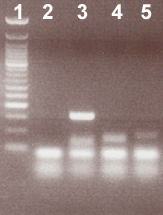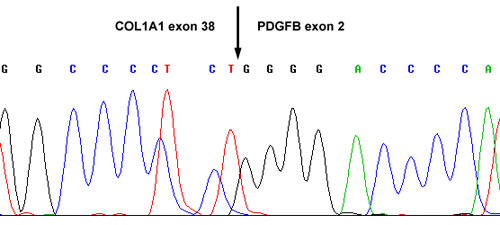The reciprocal translocation t(17;22)(q22;q13) and supernumerary ring chromosome r(17;22) are hallmarks of a tumor disease called dermatofibrosarcoma protuberans (DFSP) and its variants.
Both aberrations give rise to a fusion gene composed of the gene for collagen type Iα1 (COL1A1) localized on the chromosome 17 and the gene for a β chain of the platelet derived growth factor (PDGFB, platelet-derived growth factor B subunit) from the chromosome 22. The break occurs most frequently in the intron 1 of the gene PDGFB and at least in 20 introns of the gene COL1A1 leading to a considerable structural heterogeneity of the fusion gene COL1A1/PDGFB.
COL1A1/PDGFB fusion replaces the strong negative regulatory sequences placed in 5` region of the gene PDGFB for the promotor sequences of the gene COL1A1, the main structural protein of connective tissues extracellular matrix. That probably leads to the activation of the PDGFB gene expression and after autocrine stimulation of the PDGF receptor to the tumor transformation.
The PDGF receptor belongs to the group of tyrosine kinases which are selectively inhibited by specific low-molecular-weight substances, type of imatinib mesylate. That has lead to an idea of using this inhibitor in the treatment of DFSP. The latest studies then suggest that patients with the metastatic DFSP respond relatively well to the treatment by this preparation.
Examination
To detect the translocation t(17;22)(q22;q13) we use a single-round RT-PCR (fig. 1) followed by verification of the fusion product using direct sequencing (fig. 2). At the same time, the PGDFB gene break is detected using break apart FISH probe.
References
- McArthur G. Molecular targeting of dermatofibrosarcoma protuberans: a new approach to a surgical disease. J Natl Compr Canc Netw. 2007;5(5):557-562.
- Sirvent N, Maire G, Pedeutour F. Genetics of dermatofibrosarcoma protuberans family of tumors: from ring chromosomes to tyrosine kinase inhibitor treatment. Genes Chromosomes Cancer. 2003;37(1):1-19. Review.
- Wang J, Hisaoka M, Shimajiri S, Morimitsu Y, Hashimoto H. Detection of COL1A1-PDGFB fusion transcripts in dermatofibrosarcoma protuberans by reverse transcription-polymerase chain reaction using archival formalin-fixed, paraffin-embedded tissues. Diagn Mol Pathol. 1999;8(3):113-119.




